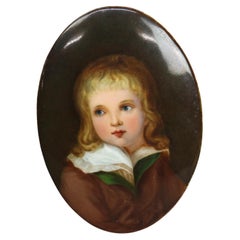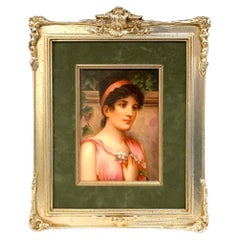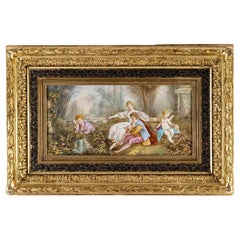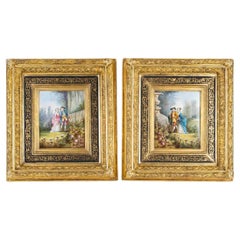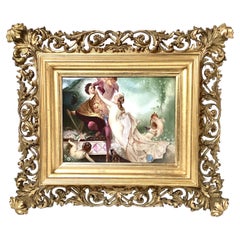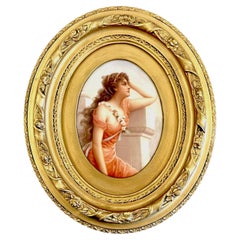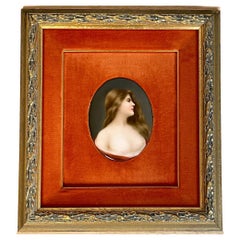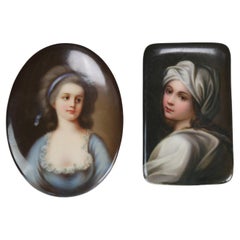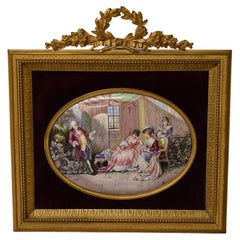Painting On Porcelain
Antique Late 19th Century Porcelain
Porcelain
Early 20th Century German Belle Époque Porcelain
Porcelain, Velvet, Giltwood
Antique 19th Century French Napoleon III Paintings
Porcelain, Stucco
Antique 19th Century French Napoleon III Paintings
Porcelain, Stucco
Antique 1880s Austrian Paintings
Porcelain, Giltwood
Early 20th Century German Belle Époque Porcelain
Porcelain, Giltwood
Early 20th Century German Belle Époque Paintings
Porcelain, Velvet, Giltwood
Antique Late 19th Century Paintings
Porcelain
Antique Late 19th Century European Aesthetic Movement Paintings
Porcelain
Antique Late 19th Century German Porcelain
Porcelain, Velvet, Giltwood
Antique 19th Century Paintings
Early 20th Century Paintings
Porcelain
Antique 19th Century Wall-mounted Sculptures
Porcelain
Antique 19th Century Wall-mounted Sculptures
Porcelain
Antique Late 19th Century Paintings
Porcelain
Antique Late 19th Century Belgian Decorative Art
Porcelain, Paint
Antique Mid-19th Century Paintings
Porcelain
20th Century Unknown Porcelain
Porcelain
Antique Late 19th Century Grand Tour Historical Memorabilia
Bronze
Antique 1890s European Art Nouveau Paintings
Porcelain, Maple, Giltwood
20th Century European Other Paintings
Porcelain
Antique 1890s French Napoleon III Paintings
Porcelain, Wood
Vintage 1940s Swedish Brooches
Silver
20th Century Portrait Paintings
Porcelain
Antique Late 19th Century German Other Paintings
Porcelain
Early 20th Century German Porcelain
Giltwood, Porcelain
Antique 19th Century German Victorian Paintings
Porcelain
Antique 19th Century Paintings
Brass
Antique 19th Century German Porcelain
Porcelain
Early 20th Century German Renaissance Paintings
Porcelain
2010s French Art Deco Porcelain
Gold Plate
Antique Mid-19th Century Chinese Baroque Porcelain
Porcelain
Antique 18th Century English Georgian Paintings
Porcelain, Giltwood, Paint
Antique Late 19th Century German Paintings
Giltwood, Porcelain
Early 20th Century German Classical Greek Paintings
Porcelain, Wood
Mid-20th Century German Biedermeier Porcelain
Porcelain
Early 20th Century French Art Nouveau Porcelain
Gold
1890s Art Nouveau Figurative Paintings
Porcelain, Oil
2010s French Art Deco Porcelain
Gold Plate
Antique Mid-18th Century English Neoclassical Porcelain
Porcelain
Antique Late 19th Century German Paintings
Porcelain
Antique Early 1800s English George III Porcelain
Porcelain
20th Century European Neoclassical Revival Decorative Art
Other
Antique Late 19th Century French Art Nouveau Paintings
Porcelain
Antique Late 19th Century German Decorative Art
Porcelain
Antique Early 1900s American Belle Époque Paintings
Paint, Parchment Paper
20th Century Landscape Paintings
Porcelain
Antique 19th Century British Folk Art Paintings
Porcelain, Velvet, Paint, Glass
21st Century and Contemporary Realist Still-life Paintings
Copper
Antique 19th Century Paintings
Porcelain, Paint
Antique 1870s Paintings
Porcelain
Antique 1850s German Baroque Decorative Art
Porcelain, Giltwood
19th Century Portrait Paintings
Porcelain
2010s Abstract Impressionist Still-life Paintings
Linen, Oil
Antique 19th Century German Renaissance Decorative Art
Porcelain, Giltwood
Mid-20th Century Hungarian Other Porcelain
Porcelain
Antique 19th Century Paintings
Porcelain
Antique 19th Century German Neoclassical Decorative Art
Porcelain, Giltwood
Antique 19th Century Unknown Victorian Paintings
Porcelain, Wood, Giltwood
Antique Late 19th Century Austrian Paintings
Porcelain
- 1
Painting On Porcelain For Sale on 1stDibs
How Much is a Painting On Porcelain?
- 1stDibs ExpertOctober 7, 2024The difference between semi-porcelain and porcelain is the temperature at which it is produced and its appearance. Both types of pottery usually come from kaolin clay, but porcelain gets fired at higher temperatures than semi-porcelain. Consequently, porcelain has a translucent appearance, while semi-porcelain is opaque. In addition, semi-porcelain is usually more water-absorbent than porcelain. Explore a wide range of porcelain and semi-porcelain pieces on 1stDibs.
- What was porcelain used for?1 Answer1stDibs ExpertMay 30, 2024Porcelain was once used for many of the same purposes as it is today. Ancient Chinese artisans invented the material and created statues, trinkets, cups, plates, teapots and other dinnerware and serveware, just as contemporary manufacturers do. Today, porcelain is also a key material in the manufacturing of electrical insulation, plumbing fixtures, tiling, dental bridges and crowns and many other items. Find a large selection of porcelain wares on 1stDibs.
- Where was porcelain made?1 Answer1stDibs ExpertFebruary 27, 2024Porcelain was first made in China. Artisans began producing early forms during the Tang Dynasty, which lasted from 618 to 907 A.D. During the Yuan Dynasty from 1279 to 1368, crafting techniques advanced to produce the strong, translucent pottery that we call porcelain today. Shop a wide variety of porcelain objects on 1stDibs.
- What is feldspar porcelain?1 Answer1stDibs ExpertMarch 22, 2022Feldspar porcelain is a type of ceramic made from a blend of kaolin clay and the mineral feldspar. The mix of ores gives the porcelain a translucent gray-blue appearance. Rorstrand is known for producing feldspar porcelain décor. On 1stDibs, shop a range of feldspar porcelain decorative objects.
- What is Hirado porcelain?1 Answer1stDibs ExpertApril 5, 2022Hirado porcelain or Hirado ware is made in Japan. Most often it’s made in Makawachi so you will hear it referred to as Mikawachi ware at times. A sometsuke underglaze of cobalt and white is most popular as it highlights the fine grain of the porcelain and the complicated details and elaborate openwork. Shop a collection of Hirado ware from some of the world’s top sellers on 1stDibs.
- What is vitro porcelain?1 Answer1stDibs ExpertMarch 22, 2022Vitro-porcelain is a variety of glass. It gets its name from its pressed construction, which gives it the look of porcelain or pottery. John George Sowerby invented the material in 1877. On 1stDibs, shop a range of porcelain decorative objects.
- What is a porcelain socket?1 Answer1stDibs ExpertOctober 12, 2021A porcelain socket is a socket made of porcelain. It can endure higher temperatures when compared to other materials. If the light is outside or hangs with a bulb facing down, a porcelain socket is the best recommended. On 1stDibs, find a variety of antique and vintage porcelain socket lamps.
- What is a porcelain sign?1 Answer1stDibs ExpertOctober 5, 2021Porcelain signs are thin metal sheets bonded with durable glass coating at a high temperature. It is further coated with enamel for protection. Because of its multi-layer coating, these signs are thicker than painted metal signs. Visit 1stDibs for a collection of porcelain signs.
- What is a porcelain vase?1 Answer1stDibs ExpertMarch 22, 2022A porcelain vase is a vessel made out of vitrified pottery. Porcelain is a semi-translucent white color and has a smooth, sleek texture. Traditionally, people use porcelain vases to hold fresh, dried and silk flower arrangements, but you can also display them empty as decorative accents. Find a range of antique and vintage porcelain vases on 1stDibs.
- What is Bavarian porcelain?1 Answer1stDibs ExpertApril 5, 2022Bavarian porcelain is characterized by its delicate translucent porcelain and finely decorated designs. The colorful designs often depicted hand-painted floral scenes and figurines. Shop a collection of Bavarian porcelain from some of the world’s top sellers on 1stDibs.
- What is porcelain made of?1 Answer1stDibs ExpertFebruary 22, 2021Porcelain is made up of kaolin, feldspar, quartz, and clay. It is created using a two-ore firing process.
- What is Lladró porcelain?1 Answer1stDibs ExpertApril 5, 2022Lladró is known for its porcelain figurines and sculptures. Lladró high porcelain creations express beauty and technical perfection and are meticulously made. The designs pay high attention to detail, which results in life-like figurines and bold sculptures that represent a wide range of ideas and motifs. Find a selection of Lladró porcelain on 1stDibs.
- What is in porcelain clay?1 Answer1stDibs ExpertApril 5, 2022Most porcelain contains a mixture of silica, clays, feldspar and kaolin. In the case of bone china, bone ash is also included. Porcelain is a ceramic and is made like all others by mixing clay with additives, shaping it and then firing it in a kiln. Where porcelain differs is the ingredient mixture, often containing kaolin and the fact that it’s fired at a hotter temperature. Shop a range of antique and vintage porcelain on 1stDibs.
- When was porcelain invented?1 Answer1stDibs ExpertMay 3, 2024Porcelain was invented during the Tang Dynasty in China, which began in 618 A.D. and ended in 907. Pieces produced during this period tended to be very simple and might not be easily recognizable as porcelain to modern-day collectors. The form of porcelain that most people envision today emerged during the Yuan Dynasty, which occurred between 1279 and 1368 A.D. On 1stDibs, shop a large selection of porcelain.
- What is Japanese porcelain?1 Answer1stDibs ExpertApril 5, 2022The creation of Japanese porcelain began in the late 1500s. Although the styles and variations of Japanese porcelain range, many consider Kyushu to be the center of Japanese porcelain production. You’ll find a variety of antique and modern Japanese porcelain pieces on 1stDibs.
- What is a porcelain plate?1 Answer1stDibs ExpertApril 22, 2024A porcelain plate is a dish made out of a material called porcelain. A type of ceramic, porcelain is made out of highly refined clay that gets fired at high temperatures. Porcelain plates have an appealing translucent appearance and are harder and less porous than other types of ceramic dinnerware. On 1stDibs, explore a selection of porcelain plates.
- 1stDibs ExpertSeptember 23, 2024There are a few ways to identify porcelain marks. The quickest method is photographing the marking and performing a reverse image search. Often, this approach will allow you to quickly identify the maker of your porcelain. Alternatively, you can type a short description of the mark into a search engine or review trusted reference websites that show images of popular makers’ markings. If these approaches don't provide you with enough information to make a confident identification, a certified appraiser or knowledgeable antique dealer can assist you. On 1stDibs, find a large selection of porcelain.
- 1stDibs ExpertFebruary 1, 2024To date Nymphenburg porcelain, look for a maker's mark in an inconspicuous area. Since its commission in 1754, the porcelain factory has used a wide range of marks to identify its pieces. By comparing the mark on your porcelain ware to images shared on trusted online resources, you can approximate its age. For example, a coat of arms marking above the brand's wordmark and the number 1754 indicate a piece produced in 2008 or after. If you have difficulty determining the age of a particular piece, a knowledgeable appraiser or antique dealer can assist you. Find a diverse assortment of Nymphenburg porcelain ware on 1stDibs.
- 1stDibs ExpertMay 30, 2024To date Japanese porcelain, examine its markings. Generally, the name Nippon appeared on pieces produced between 1891 and 1921. From 1945 to 1952, makers placed a mark that read "Made in Occupied Japan." A piece that is marked simply "Japan" or "Made in Japan" may date from the period just before or during World War II or from after the end of occupation in 1952. When in doubt, consult a certified appraiser or knowledgeable antiques dealer for help with dating. On 1stDibs, shop an assortment of Japanese porcelain.
- How is porcelain used today?1 Answer1stDibs ExpertFebruary 13, 2024Today, porcelain is used in a variety of ways. Due to its strength, appealing appearance and insulating properties, porcelain is a popular material for crafting drinkware and tableware as well as decorative objects. Manufacturers also produce electric insulation, dental bridges, tile and bathroom fittings out of porcelain. Explore a large selection of porcelain ware on 1stDibs.
